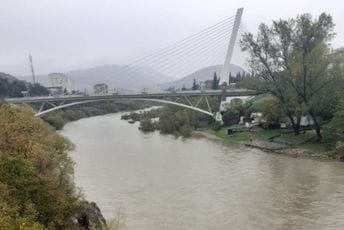Osim oružanih snaga i druge američke jedinice, naročito Crveni krst, takođe su bile prisutne u Crnoj Gori prvih poslijeratnih godina. Crveni krst je svoje sudjelovanje u Crnoj Gori zapravo počeo još 1915. godine, kada je agent sanitarne komisije u Srbiji, Albaniji i Crnoj Gori uspio povećati pomoć za vrijeme epidemije tifusa u regiji.
Publicista Slobodan Jovanović u feljtonu "Anglo-američka uloga u crnogorskom pitanju" o njihovom prisustvu u Crnoj Gori piše:
"Zatim, u svjetlu austrougarske okupacije Crne Gore u januaru 1916. crnogorski konzul u Sjedinjenim Američkim Državama, Anto Seferović, uključio se u Crveni krst radi slanja materijala u svoju domovinu. Iako društvo nije bilo u poziciji da djeluje u Crnoj Gori između 1916. i 1918. godine, iznijeli su mišljenje da će biti velika potreba za pomoći kad mir bude napokon postignut - i bili su u pravu.
Pomoć jedinice američkog Crvenog krsta počela je dolaziti u Crnu Goru u zimu krajem 1918. i početkom 1919. godine. Tri godine od okupacije su iscrpljene zalihe hrane i odjeće. Prema izvještajima, podnesenim u sjedištu Crvenog krsta, gotovo cijela populacija je patila od neishranjenosti i nosila staru odjeću ili krpe. Nedovoljno je bilo ljekara da se brine za medicinske potrebe 300.000 - 400.000 ljudi, a nije bilo ni bolnica ili zalihe lijekova vrijedne spomena. Crveni krst je gotovo odmah pokrenuo široku paletu humanitarnih operacija: pružanje liječničke i stomatološke usluge, distribuciju odjeće, održavanje narodne kuhinje i krojačnica, obuku osoblja za njegu, vođenje sirotišta, pomaganje školama, itd. Društvo je odmah postavilo četiri bolnice u Crnoj Gori, po jednu u Podgorici, Cetinju, Nikšiću i Kolašinu, u prvih devet mjeseci 1919. oni tretiraju više od 22.000 slučajeva. Isto tako, Crveni krst je donio modernu stomatologiju u Crnu Goru".

Američka pomoć u brojkama: U prvih nekoliko mjeseci 1919. usamljeni stomatolog, kapetan Bruce Wolff, izvadio je više od 1.500 zuba.
"U periodu od maja do oktobra 1919. Crveni krst je distribuirao 6.000 paketa kompleta stare odjeće, kao i desetine hiljada razdvojenih komada. Tokom 1919, posebno u zimskim i proljećnim mjesecima, održavao je narodne kuhinje u Podgorici, Cetinju, Nikšiću i Grahovu, u kojima se služilo 126.000 obroka od februara do aprila 1919. godine. Centri za distribuciju hrane su postavljeni i drugdje po zemlji. U 1919. oko deset posto svih zaliha, odjeće i novca izdvojenih za Balkan je poslato u Crnu Goru. Šest od pedeset doktora otišlo je u Crnu Goru, kao i neproporcionalno veliki procenat kamiona, ambulantnih vozila, automobila, motocikla, kuhinjskih prikolica i benzina.
Jedan oduševljeni radnik američkog Crvenog krsta komentarisao je da je “spašavanje Crne Gore od uništenja i gladi, postignuto zahvaljujući američkoj industriji automobila, američkim vozačima i američkoj energiji", navodi Jovanović.
(http://www.portalanalitika.me/clanak/128109/anglo-americka-uloga-u-crnogorskom-pitanju-5-odlazak-drzave-crne-gore-u-istoriju)
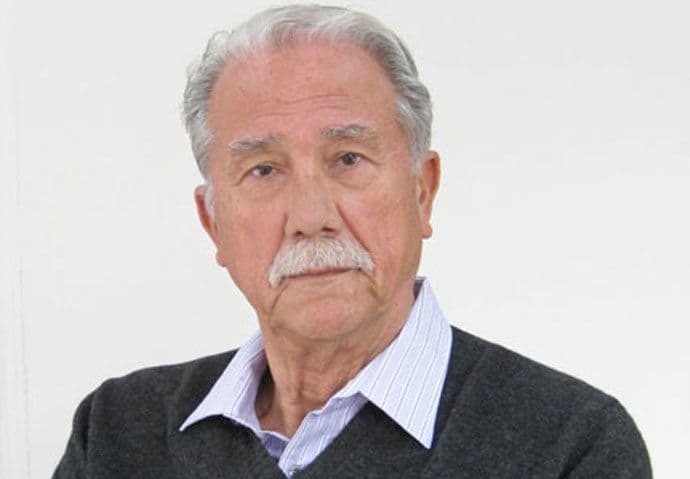
Katastrofalno stanje nakon Velikog rata: O tome kakvo je stanje vladalo u to vrijeme u Crnoj Gori Blažo Sredanović u tekstu "Američki Crveni krst u Crnoj Gori", piše:
"Kakvih sve bolesti nije bilo tada u ratom i izdajom poharanoj Crnoj Gori! Najrasprostranije su bile malarija i tuberkoloza i česte parazitske infekcije, uključujući dizinteriju i trihinozu. Povremeno su se javljali tifus i male boginje. Venerične bolesti bile su prije rata gotovo nepoznate, ali su ubrzo postale ozbiljan problem. Stanje sa zubima, posebno kod djece, bilo je očajno. Jedan zubar teško je stizao svuda. Kad bolove nijesu mogli podnositi neki su išli kod kovača da im izvadi pokvareni zub! Veoma česte infekcije kože, gotovo se nijesu smatrale za bolest, već nedostatak higijene, posebno sapuna. Često se nekoliko familija služilo jednim česljem. Anemična, neuhranjena i napuštena đeca u dronjcima, gotovo goli, spavaju po ulazima i trotoarima prekriveni prljavim vrećama. Crnoj Gori je prijetila demografska katastrofa. I većina odraslih bila je u krpama, jer je Austrija uništila stočni fond, posebno ovce, pa je bila oskudica vune.”
(http://portalanalitika.me/clanak/169244/arhiv)
Američki Crveni krst ostao četiri godine: Američki Crveni krst je ostao u Crnoj Gori više od četiri godine. Posljednja jedinica je povučena početkom ljeta 1922.
Portal Analitika objavljuje originalna svjedočenja na engleskom jeziku iz arhiva Američkog crvenog krsta sa zabilješkama i fotografijama njihovog osoblja. Svjedočenja i fotografije koje su oni zabilježili tokom svoga boravka i nesebičnog rada u Podgorici nakon Velikog rata.
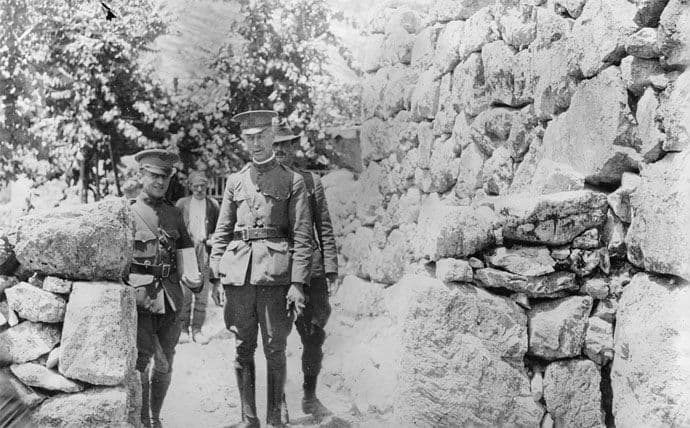 Slika 1
Slika 1Americans solve difficult problems. Major J. T. Jaros of Chicago and Colonel H. R. Fairlow of Leland Stanford University in California on a tour of investigation for the American Red Cross in the mountains of Montenegro. Cut off from all sources of supplies by distruction [sic] of bridges and every possible means of transportation, thousands of people were held in the in the [sic] fastness of the Black mountains like prisoners awaiting death from starvation. Red Cross workers finally solved the transportation riddle and saved them by means of cables stretched across rivers and streams over which they conveyed food, medicines and servicable clothing
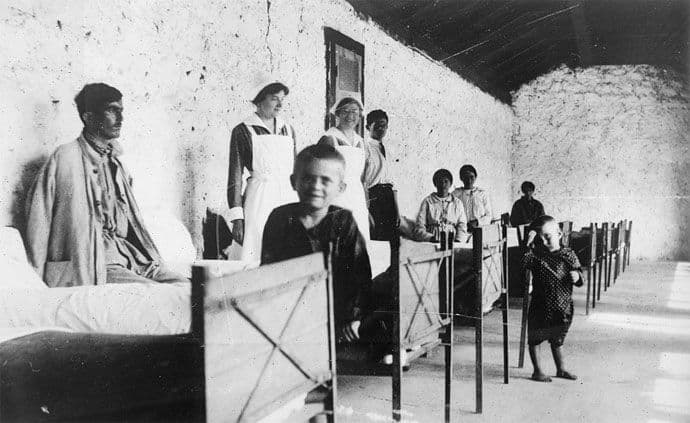 Slika 2
Slika 2Saving Montenegro's Starving War Orphans. In a sunny hospital ward at Podgoritza, Junior Red Cross nurses are saving many war orphans of Montenegro. The little boy, a tubercular, in the aisle has a stunt that pleases and amuses every hospital visitor. He salutes gravely to welcome the newcomer. The nurses here shown are Miss Minnie T. Buelhauser of N.Y.C., & Miss H.A. Wiltzius of Chicago
 Slika 3
Slika 3The Good Ship 'Relief' from America. Joy is everywhere on the tiny country of Montenegro when an American steamer arrives bringing supplies American Red Cross Chapter bales of clothing, food and medical supplies. The natives lend their support in unloading the great cargo and at the distribution centers scattered throughout the land the needy and suffering await the apportionment
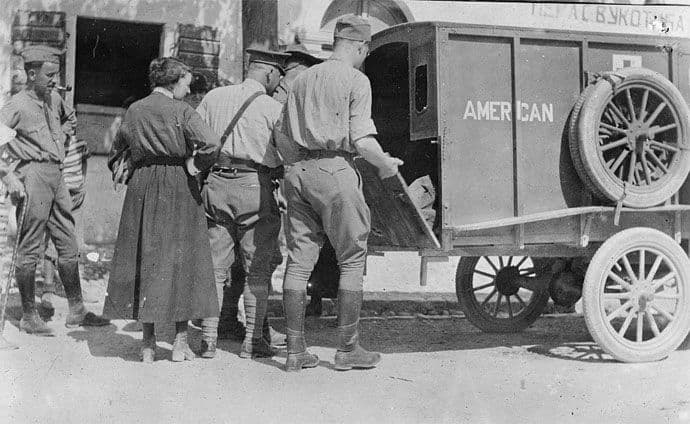 Slika 4
Slika 4American doctors and an American nurse loading an emergency gun shot patient for transportation to the A.R.C. Hospital at Podgoritas, Montenegro. Miss Olivia E. Hamilton, Philadelphia, Capt. Bruce M. Wolff, Boston, Mass., and Lt. Ralph E. Adams, West Lafayette, Ind.
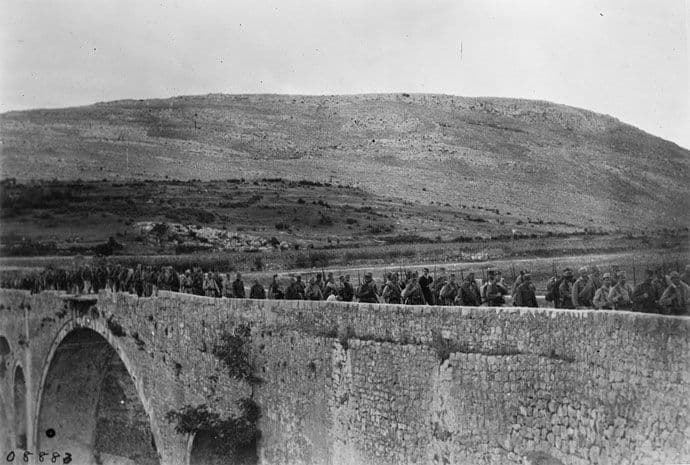 Slika 5
Slika 5Armistices come and go, but there is always trouble in the Balkans. Although the armistice was signed more than a year ago, these Serbian soldiers are still marching with full equipment. This picture was taken as a Serbian battalion was crossing an ancient Roman bridge into Montenegro … (1920)
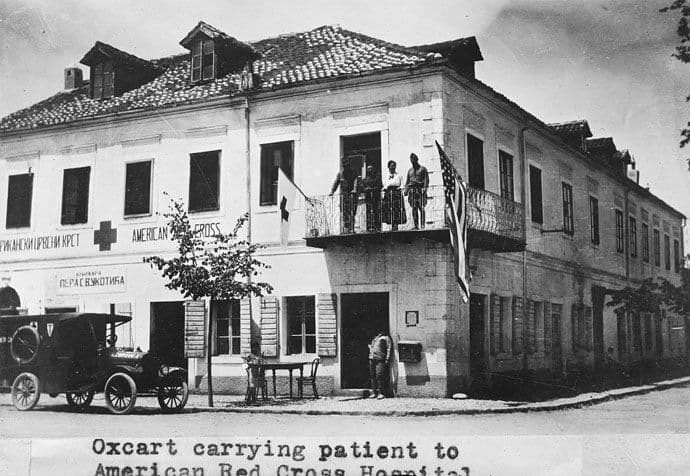 Slika 6
Slika 6American Red Cross Headquarters Podgoritza, Montenegro. Capt. C.C. Pratt, Makato, Minn., Miss E.C. Pearcem, Baltimore, Md., Lt. E.N. Tuckerman, Boston, Mass. on the balcony
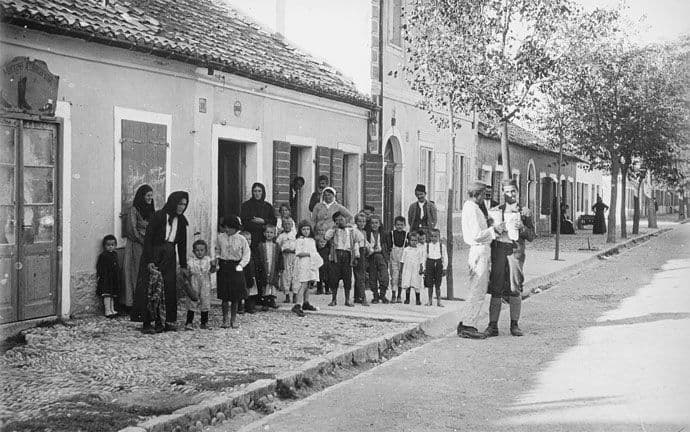 Slika 7
Slika 7Something Else to Worry About. Children outside the medical dispensary in Podgoritza, Montenegro, supported by the boys and girls of America through the Junior Red Cross, awaiting their turn to be vaccinated. The doctors and nurses sent by the Juniors of America to look after the health of their little Montenegrin comrades found that health and sanitary conditions were so bad that they decreed a wholesale vaccination of the populace. So the school children were sent to the dispensary in groups. Some of them were not at all sure as to what would happen to them and brought their mothers along for protection
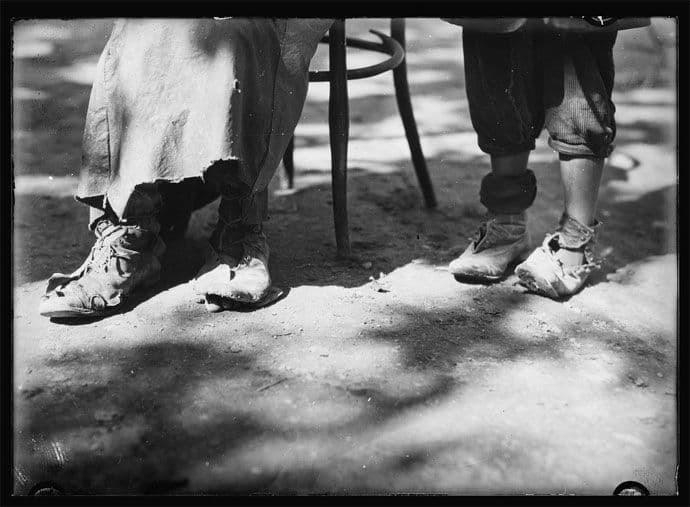 Slika 8
Slika 8Lost Soles. Illustrating the conditions as regards footwear that exist in Southern Europe today. The picture shows the feet of a mother and son who came to the American Red Cross station in Podgoritza, Montenegro, asking for aid. During the war, many soldiers went shoeless, even in winter, several thousand losing their legs as a result of frozen feet. Red Cross doctors say that 25 percent of the winter illness in these countries today is caused by lack of proper clothing and foot protection. The American relief organization has already distributed several tons of used American clothing and shoes in Montenegro
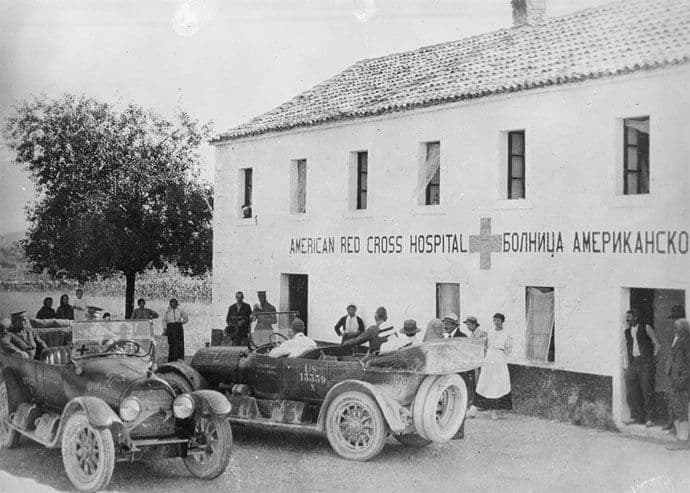 Slika 9
Slika 9Only hospital within sixty miles. The American Red Cross institution at Nicsic, Montenegro, for the care of sick and wounded. When the Red Cross Unit arrived here a few months before, there was no roof on the building and half a dozen families were living in the cellar. They reconstructed and cleaned the place, fed the needy of the district and set out to cure the sick. When this picture was taken, Lieut. Col. Robert E. Olds, of St. Paul Minn. (seated in car, extreme left) Red Cross Commissioner for Europe and Lieut. Col. Frederick Keppel, Washington Director of Red Cross Foreign relief (rear seat of car to right) were inspecting the Hospital on their tour of the Balkans
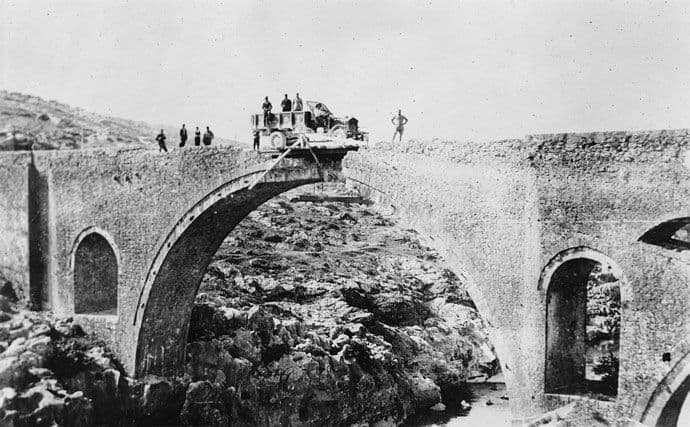 Slika 10
Slika 10American Repair Balkan Bridge. Many of the bridges of Montenegro were destroyed or wrecked by the retreating Austrians. Through the efforts of the American Red Cross transportation department, many of them have been repaired and maintained in a fairly safe condition, although permanent repairs are a matter to be taken up later by the Serbian government. These temporary repairs have been necessary for the carrying out of the work of the Red Cross, making possible the successful transportation of supplies for relief. The bridge in the photograph was built by a Turkish pasha 500 years ago and is a fine example of thoroughgoing early construction. Although the Austrians placed several heavy charges of dynamite under the arch, the bridge withstood the shock fairly well
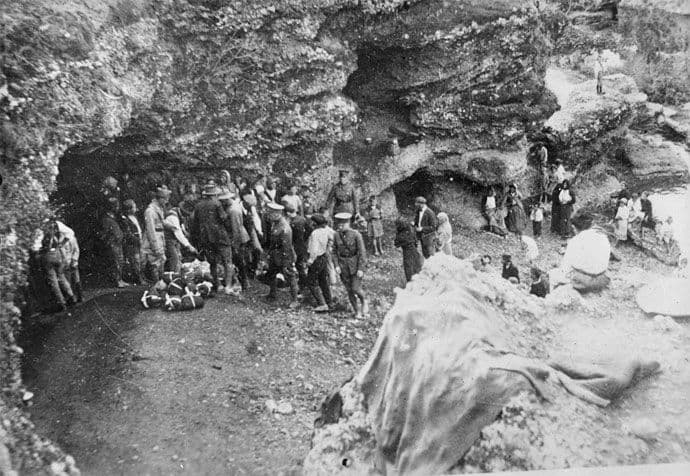 Slika 11
Slika 11Back to the Stone Age. Living in catacombs with no modern comforts, little clothing and cooking their scanty food on hot stones, American Red Cross Workers discovered hundreds of people among the crags of the Montenegrin Mountains. Driven from their homes and made widows by the war. Thirteen mothers were found with their children living in this one cave. This shows American Red Cross workers delivering clothing and food to them. So fear struck and uncouth had the families become as a result of their cave life that they did not know whether the Americans were friends or enemies at first. Destitution and misery like this exists all through the Balkans
 Slika 12
Slika 12Another load of war sufferers. American Red Cross doctors and nurses in front of their hospital at Podgoritzn, Montenegro, during the arrival of an American Red Cross ambulance from the remote mountain districts, loaded with sick and ailing peasants who are to be treated at the American institution. The Red Cross workers in the group, from left to right are: Lieut. Russell B. Bean of Kansas City, Miss Alinia E. Hamilton, of New York City, Capt. B.M. Wolff, of Allston, Mass., and Miss Henen G. Cairns, of Baltimore, Md. The Montenegrin boy is "Samson" so named because of the heavy buckets of water he carries
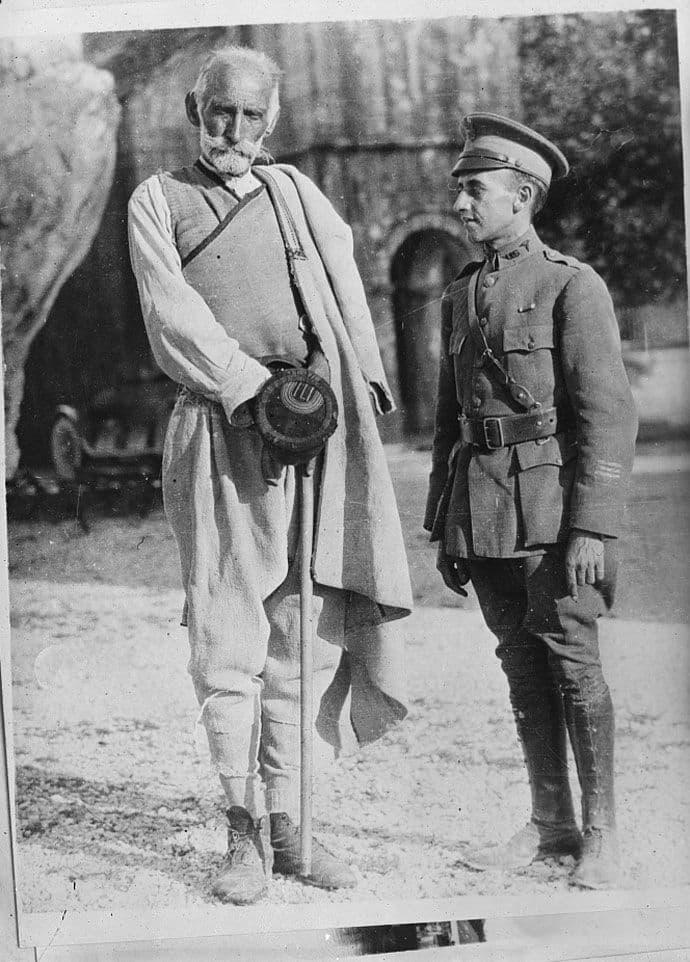 Slika 13
Slika 13A Foxy Old Mayor of Montenegro. When Dr. Joseph F. Jaros of Chicago, medical director of the American Red Cross unit in Montenegro (left) saved his Montenegrin companion's son and daughter from Typhoid fever, the venerable old fellow attempted to pay for the American's services. When it was refused he presented the American doctor with a live fox, caught by himself, as a token of his appreciation. The aged man has seen eighty summers, is mayor of his mountain village and is the personification of Montenegrin dignity as his pose shows
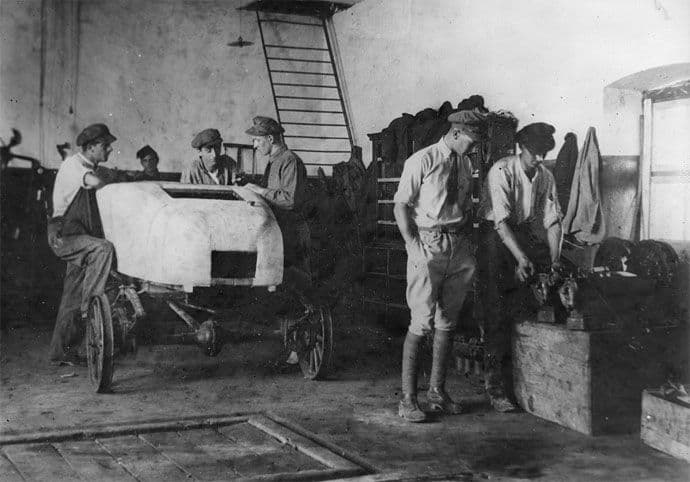 Slika14
Slika14Piecing 'em Together. An interior view of the American Red Cross garage at Podgoritza, Montenegro one of the organizations transportation bases in the Balkans. Here Americans have organized a corps of native mechanics. Due to the rough usage the cars get in distibuting Red Cross relief supplies over the mountain roads, these men have a difficult problem in keeping the automobiles in operation. No spare parts are available so it is necessary to make substitute appliances or transfer parts from one car to another continually. In the foreground to the right is Lieut. Thomas Ward, of Salinas, Calif., in charge of the garage
Fotografije su većinom datovane na 1920. godinu. Čuvaju se kao negativi na staklu. Zbirka se vodi kao American National Red Cross photograph collection (Library of Congress). Nalaze se u Library of Congress, Vašington.
Ivan KERN




